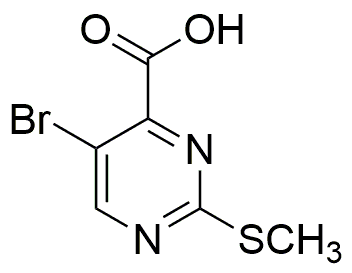5-Bromo-2-(methylthio)pyrimidine-4-carboxylic acid is widely utilized in research focused on:
- Pharmaceutical Development: This compound serves as a key intermediate in the synthesis of various pharmaceuticals, particularly in the development of antiviral and anticancer agents.
- Agricultural Chemistry: It is used in the formulation of agrochemicals, helping to create effective herbicides and fungicides that enhance crop protection and yield.
- Biochemical Research: Researchers employ this compound in studies related to enzyme inhibition and metabolic pathways, contributing to a better understanding of biological processes.
- Material Science: It finds applications in the development of novel materials, including polymers and coatings, that require specific chemical properties for enhanced performance.
- Analytical Chemistry: This chemical is utilized as a standard in analytical methods, aiding in the accurate detection and quantification of similar compounds in various samples.
Informations générales
Propriétés
Sécurité et réglementation
Applications
5-Bromo-2-(methylthio)pyrimidine-4-carboxylic acid is widely utilized in research focused on:
- Pharmaceutical Development: This compound serves as a key intermediate in the synthesis of various pharmaceuticals, particularly in the development of antiviral and anticancer agents.
- Agricultural Chemistry: It is used in the formulation of agrochemicals, helping to create effective herbicides and fungicides that enhance crop protection and yield.
- Biochemical Research: Researchers employ this compound in studies related to enzyme inhibition and metabolic pathways, contributing to a better understanding of biological processes.
- Material Science: It finds applications in the development of novel materials, including polymers and coatings, that require specific chemical properties for enhanced performance.
- Analytical Chemistry: This chemical is utilized as a standard in analytical methods, aiding in the accurate detection and quantification of similar compounds in various samples.
Documents
Fiches de données de sécurité (FDS)
La FDS fournit des informations de sécurité complètes sur la manipulation, le stockage et l’élimination du produit.
Spécifications du produit (PS)
Le PS fournit une description complète des propriétés du produit, notamment sa composition chimique, son état physique, sa pureté et les exigences de stockage. Il détaille également les plages de qualité acceptables et les applications prévues du produit.
Certificats d'analyse (COA)
Recherchez des certificats d'analyse (COA) en saisissant le numéro de lot du produit. Les numéros de lot et de lot se trouvent sur l'étiquette d'un produit, après les mots « Lot » ou « Lot de fabrication ».
Numéro de catalogue
Numéro de lot/série
Certificats d'origine (COO)
Ce certificat d'exploitation confirme le pays dans lequel le produit a été fabriqué, et détaille également les matériaux et composants utilisés et s'il est issu de sources naturelles, synthétiques ou autres sources spécifiques. Ce certificat peut être requis pour les douanes, le commerce et la conformité réglementaire.
Numéro de catalogue
Numéro de lot/série
Fiches de données de sécurité (FDS)
La FDS fournit des informations de sécurité complètes sur la manipulation, le stockage et l’élimination du produit.
DownloadSpécifications du produit (PS)
Le PS fournit une description complète des propriétés du produit, notamment sa composition chimique, son état physique, sa pureté et les exigences de stockage. Il détaille également les plages de qualité acceptables et les applications prévues du produit.
DownloadCertificats d'analyse (COA)
Recherchez des certificats d'analyse (COA) en saisissant le numéro de lot du produit. Les numéros de lot et de lot se trouvent sur l'étiquette d'un produit, après les mots « Lot » ou « Lot de fabrication ».
Numéro de catalogue
Numéro de lot/série
Certificats d'origine (COO)
Ce certificat d'exploitation confirme le pays dans lequel le produit a été fabriqué, et détaille également les matériaux et composants utilisés et s'il est issu de sources naturelles, synthétiques ou autres sources spécifiques. Ce certificat peut être requis pour les douanes, le commerce et la conformité réglementaire.


